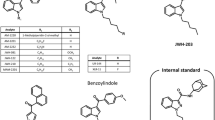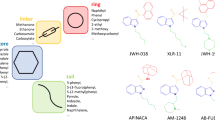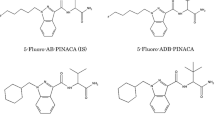Abstract
Popularity of new psychoactive substances, known as legal highs or herbal highs, is continuously growing. These products are typically sold via internet and in so-called head shops. The aim of this study was to identify active ingredients of herbal highs and to compare their chemical composition. Twenty-nine various products seized by the police in one of the “head shops” were analysed. Herbal mixtures (0.2 g) were prepared by ultrasonic-assisted extraction with 2.0 ml of ethanol for 2 h. The extracts were analysed by gas chromatography coupled to mass spectrometry (GC/MS). The main active compounds of the herbal mixtures were synthetic cannabinoids: JWH-018, JWH-073 and cannabicyclohexanol (CP-47,497-C8-homolog). Their content differed between the products; some contained only one cannabinoid whereas the others contained two or more. Cluster analysis and principal component analysis revealed that chemical composition of many products was very similar. The similarity was connected with their flavour and not the common name. This statement was true for the synthetic cannabinoids, other potential agonists of cannabinoid receptors (amides of fatty acids) and ingredients of natural origin and confirms that herbal highs are a threat to human health because the purchaser has no information on their real composition.







Similar content being viewed by others
References
A report from an EMCDDA expert meeting, Lisbon (Portugal) (2009) EMCDDA Action on new drugs briefing paper: Understanding the “Spice” phenomenon. www.tubim.gov.tr/Dosyalar/Spice.pdf, accessed on 15 March 2010
Szukalski B, Błachut D (2010) Zmodyfikowane kannabinoidy—nowe groźne narkotyki [in Polish]. Probl Krym 268:14–25
Auwarter V, Dresen S, Weinman W, Müller M, Puetz M (2009) Spice and other herbal blends: harmless incense or cannabinoid designer drugs? J Mass Spectrom 44:832–837
Uchiyama N, Kikura-Hanajiri R, Kawahara N, Goda Y (2009) Identification ofa cannabimimetic indole as a designer drug in a herbal product. Forensic Toxicol 27:61–66
Uchiyama N, Kikura-Hanajiri R, Kawahara N, Haishima Y, Goda Y (2009) Identification of a cannabinoid analog as a new type of designer drug in a herbal product. Chem Pharm Bull 57:439–441
Aung MM, Griffin G, Huffman JW, Ming-Jung W, Keel C, Yang B, Showalter VM, Abood ME, Martin BR (2000) Influence of the N-1 alkyl chain length of cannabimimetic indoles upon CB1 and CB2 receptor binding. Drug Alcohol Depend 60:133–140
Huffman JH, Mabon R, Mu MJ, Lu J, Hart R, Hurst DP, Reggio PH, Wiley JL, Martin BR (2003) 3-Indolyl-1-naphthylmethanes: new cannabimimetic indoles provide evidence for aromatic stacking interactions with the CB1 cannabinoid receptor. Bioorg Med Chem 11:539–549
Huffman JH, Thompson ALS, Wiley JL, Martin BR (2008) Synthesis and pharmacology of 1-deoxy analogs of CP-47, 497 and CP-55, 949. Bioorg Med Chem 16:322–335
Lambert D, Di Marzo V (1999) The palmitoylethanolamide and oleamide enigmas: are these two fatty acids amides cannabimimetic? Curr Med Chem 6:757–773
Leggett JD, Aspley S, Beckett SRG, D’Antona AM, Kendall DA (2004) Oleamide isa selective endogenous agonist of rat and human CB1 cannabinoid receptors. Br J Pharmacol 141:253–262
Lindigkeit R, Boehme A, Eiserloh I, Luebbecke M, Wiggermann M, Ernst L, Beuerle T (2009) Spice: a never ending story? Forensic Sci Int 191:58–63
Uchiyama N, Kikura-Hanajiri R, Ogata J, Goda Y (2010) Chemical analysis of synthetic cannabinoids as designer drugs in herbal products. Forensic Sci Int 198:31–38
Otto M (2007) Chemometrics. Statistics and Computer Application in Analytical Chemistry, Wiley, Weinheim
Dresen S, Ferreiros N, Putz M, Westphal F, Zimmermann R, Aufwarter V (2010) J Mass Spectrom 45:1186–1194
Author information
Authors and Affiliations
Corresponding author
Additional information
Published in the special issue Forensic Toxicology with Guest Editors Frank T. Peters, Hans H. Maurer, and Frank Musshoff.
Rights and permissions
About this article
Cite this article
Zuba, D., Byrska, B. & Maciow, M. Comparison of “herbal highs” composition. Anal Bioanal Chem 400, 119–126 (2011). https://doi.org/10.1007/s00216-011-4743-7
Received:
Revised:
Accepted:
Published:
Issue Date:
DOI: https://doi.org/10.1007/s00216-011-4743-7




